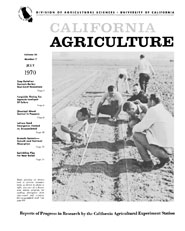


University of California
California Agriculture
|
|||
|
|||

Cover:
Hand planting of lettuce seed to precise measurement, as shown in photo to
right, was part of a desert-area testing program for seedling emergence from clay-coated and vermiculite-encapsulated seed.
July 1970
Volume 24, Number 7 |
|||
|
University of California, 1301 S. 46th St., Bldg. 478 Richmond, CA
|